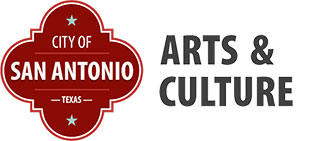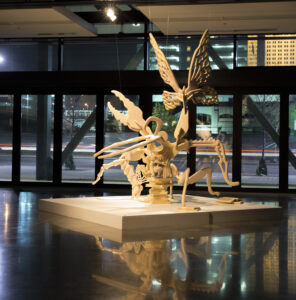Jayne Lawrence is a mixed media artist specializing in sculpture and drawing. She spent the early part of her career as a commercial artist in Denver, Colorado and relocated to San Antonio, Texas in 1983. She received a MFA in Sculpture from the University of Texas at San Antonio where she taught until her retirement in 2021.
The three key reoccurring elements in Lawrence’s work are the human figure, insects and architectural components. Lawrence says “I start from a place of knowing and end in a place of discovery, transformed.”
Lawrence has received awards from the International Sculpture Center in Hamilton, New Jersey, and completed a two-month residency at Sculpture Space in Utica, New York. LA-based, independent curator and critic Michael Duncan selected her to represent South Texas artists in a solo exhibition as part of the 2009 Texas Biennale, and again in 2013, as part of the fifth anniversary of selected past Biennial artists. In 2014, Lawrence ventured into Guatemalan jungle as part of her research for a solo exhibition at the Southwest School of Art in 2015. And in October of 2022, she participated in a three-month residency through the Blue Star Contemporary Berlin Residency Program/Künstlerhaus Bethanien International Studio Program.
Lawrence’s work has been included in numerous exhibitions including, among others:
International Sculpture Center, Hamilton, NJ, University of New Mexico Art Museum, Albuquerque, NM, Laredo Center for the
Resume (PDF)
MORE ABOUT THIS ARTIST
Artist Statement of Work
Storytelling is a fundamental tool used to help us understand our world. When repeated these stories seep into our psyche and perpetuate established behaviors and belief systems. I am interested in how stories, particularly fairytales, reflect our societal attitudes toward gender, role models, and attraction-repulsion responses. Using a symbolic language containing insects, plant life, the human figure, and architectural components I create imagery that emboldens the downtrodden, and provides alternative societal modalities where difference is accepted, change is inevitable, and logic, as we know it, is put into question. The insect represents "the other," that which is like us but is not us. Our attraction/repulsion reactions to them are largely based on socially established notions of beauty. Throughout human history the insect has represented many qualities we find admirable; transformation (the caterpillar to butterfly), endurance (story of the ant who could move the rubber tree plant), and survival (based the cicada's life cycle or the habits of social insects.) The human elements within my work are disarticulated and combine with nature to remind us that our survival is based on a symbiotic relationship with the elements and creatures around us. The architectural components represent civilization: place, land, culture, and the practices we keep. For example: a box may reference a hive /community; floor plans suggest home/ family unit/shelter, and a flying buttress is symbolic of physical, emotional, or communal support.


